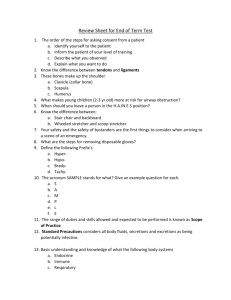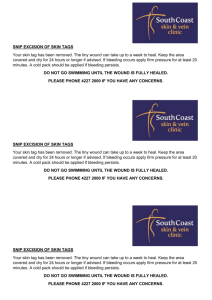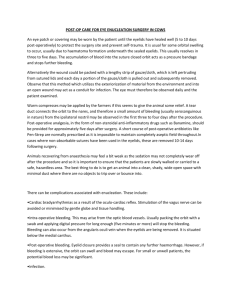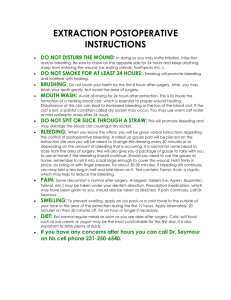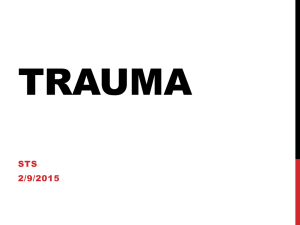Chapter 7 First Aid Notes
advertisement
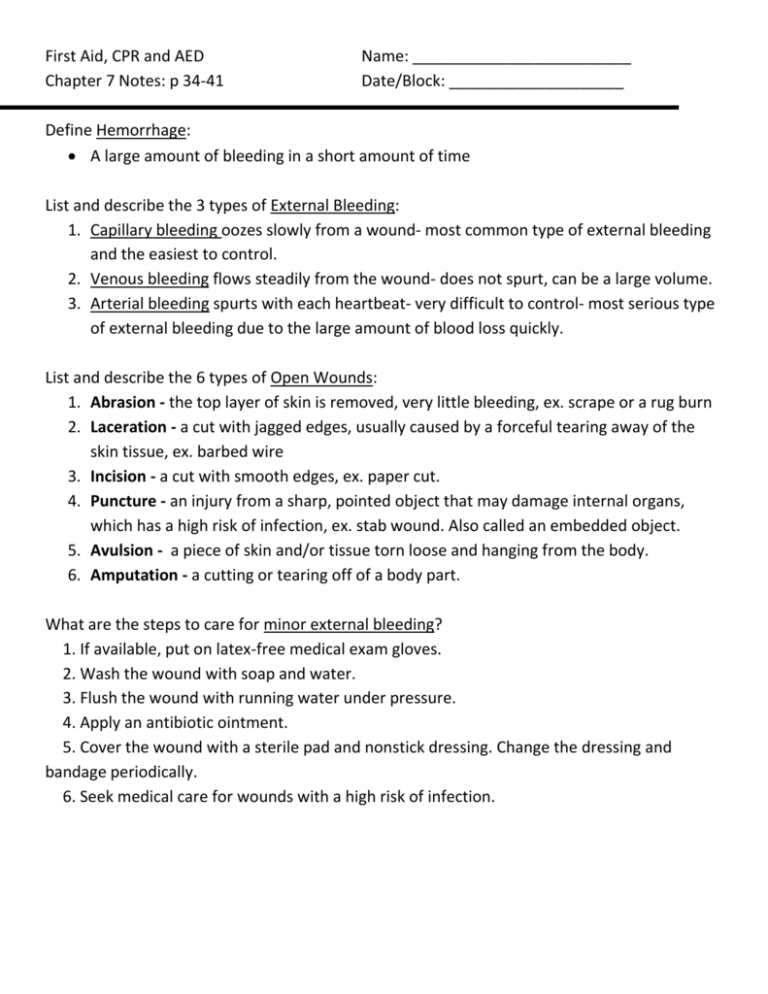
First Aid, CPR and AED Chapter 7 Notes: p 34-41 Name: _________________________ Date/Block: ____________________ Define Hemorrhage: A large amount of bleeding in a short amount of time List and describe the 3 types of External Bleeding: 1. Capillary bleeding oozes slowly from a wound- most common type of external bleeding and the easiest to control. 2. Venous bleeding flows steadily from the wound- does not spurt, can be a large volume. 3. Arterial bleeding spurts with each heartbeat- very difficult to control- most serious type of external bleeding due to the large amount of blood loss quickly. List and describe the 6 types of Open Wounds: 1. Abrasion - the top layer of skin is removed, very little bleeding, ex. scrape or a rug burn 2. Laceration - a cut with jagged edges, usually caused by a forceful tearing away of the skin tissue, ex. barbed wire 3. Incision - a cut with smooth edges, ex. paper cut. 4. Puncture - an injury from a sharp, pointed object that may damage internal organs, which has a high risk of infection, ex. stab wound. Also called an embedded object. 5. Avulsion - a piece of skin and/or tissue torn loose and hanging from the body. 6. Amputation - a cutting or tearing off of a body part. What are the steps to care for minor external bleeding? 1. If available, put on latex-free medical exam gloves. 2. Wash the wound with soap and water. 3. Flush the wound with running water under pressure. 4. Apply an antibiotic ointment. 5. Cover the wound with a sterile pad and nonstick dressing. Change the dressing and bandage periodically. 6. Seek medical care for wounds with a high risk of infection. What are the steps to care for serious external bleeding? 1. Put on latex-free medical exam gloves and expose the wound. 2. Apply a gauze pad and direct pressure to the wound. 3. Apply a pressure bandage over the gauze. Apply additional dressings and pressure bandages if blood soaks though. 4. Call 9-1-1. These are signs that a wound may be infected: Swelling, redness, fever, sensation of warmth, throbbing pain, pus discharge, swelling of lymph nodes, red streaks towards heart on skin What is tetanus? How is it treated and prevented? A bacterial infection affecting the muscle groups (usually the jaw) There is no cure Vaccinations and a booster shot every 10 years, or when needed for an animal bite or a dirty wound. To care for an amputation: 1. Call 9-1-1. 2. Control the bleeding. 3. Care for shock. 4. Recover the amputated part, wrap in dry sterile gauze. 5. Seal part in plastic bag or water proof container. 6. Keep part cool, place on top of ice, do not freeze. To care for a victim with an impaled/embedded object: 1. Leave the object in place. 2. Expose the area. Remove or cut away the victim’s clothing if necessary. 3. Stabilize the object with bulky, clean dressings. 4. Seek medical care. Medical Attention may be required for wounds with the following conditions: 1. Long/deep cuts needing stitches 6. Cuts that damage nerves, joints, tendons 2. Cuts over a joint 7. Cuts over a broken bone 3. Cuts that may impair function 8. Cuts due to a crushing injury 4. Cuts from an animal/human bite 9. Cuts with an impaled object 5. Cuts that remove all layers of skin 10. Cuts due to metal or glass Call 9-1-1 immediately if: 1. Bleeding is not controlled with direct pressure after 10-15 minutes. 2. Victim displays signs of shock: dizziness, pale/cool skin. 3. Breathing difficulty after a cut to the neck or chest. 4. A deep cut to the abdomen with moderate to severe pain. 5. Eyeball is cut. 6. Cut partially or fully amputates an extremity. What is internal bleeding? A closed wound resulting when a blunt object does not break the skin, but tissue and blood vessels beneath the surface of the skin are crushed. (A bruise!) Signs of internal bleeding include: 1. Bruising 2. Painful, tender area 3. Vomiting or coughing up blood 4. Stool that is black or contains bright red blood To care for minor internal bleeding: 1. Apply ice or a cold pack for 20 minutes. 2. Compress with an elastic bandage for 2-3 hours. 3. Elevate the injured arm or leg if it is not broken. To care for serious internal bleeding: 1. Call 9-1-1. 2. Care for shock. 3. If vomiting, roll to recovery position. 4. Monitor breathing. Define Dressing: A sterile gauze pad or clean cloth covering placed over an open wound to help absorb blood, prevent infection, and protect from further injury. Define Bandage: An elastic or cloth wrap used to cover a dressing to keep it in place and to apply pressure to help control the bleeding.

